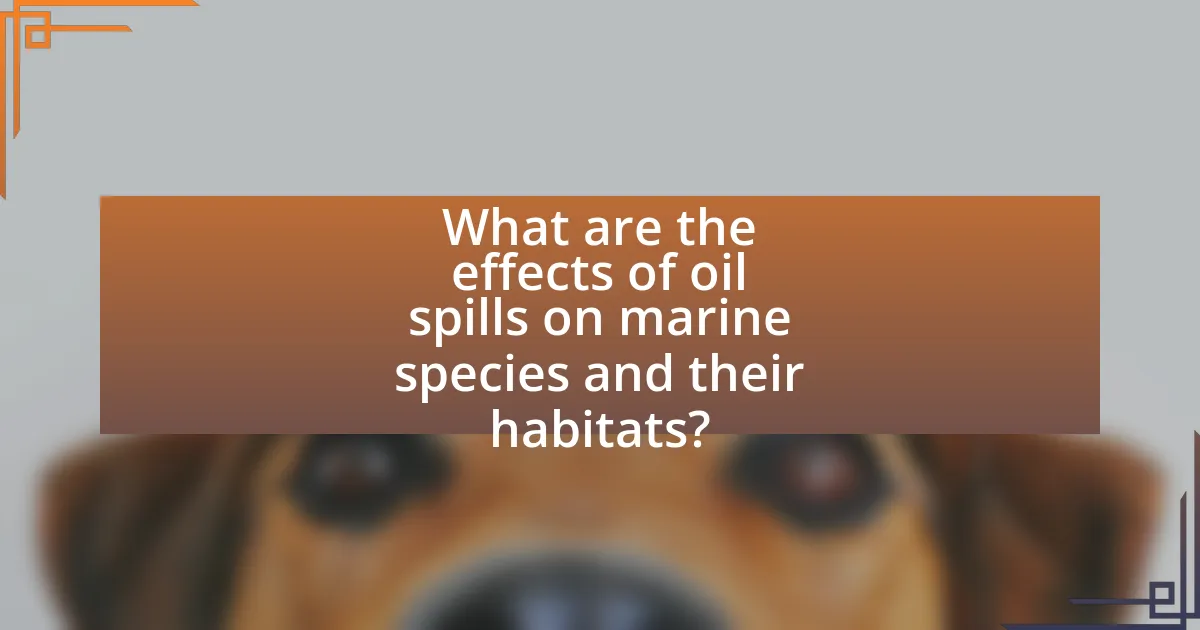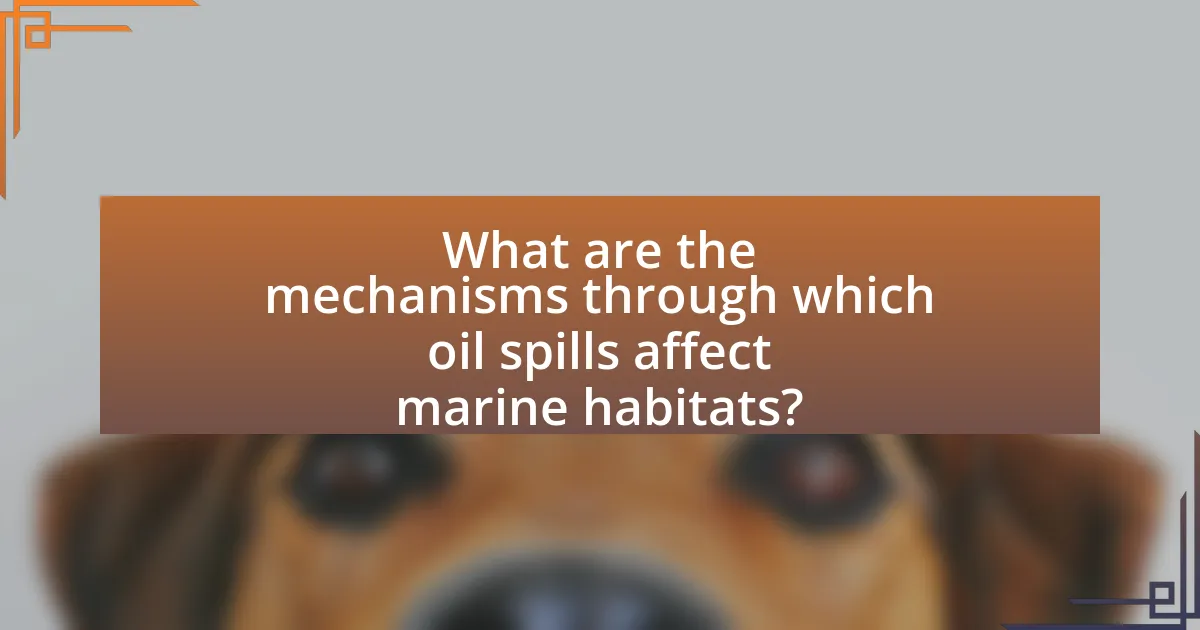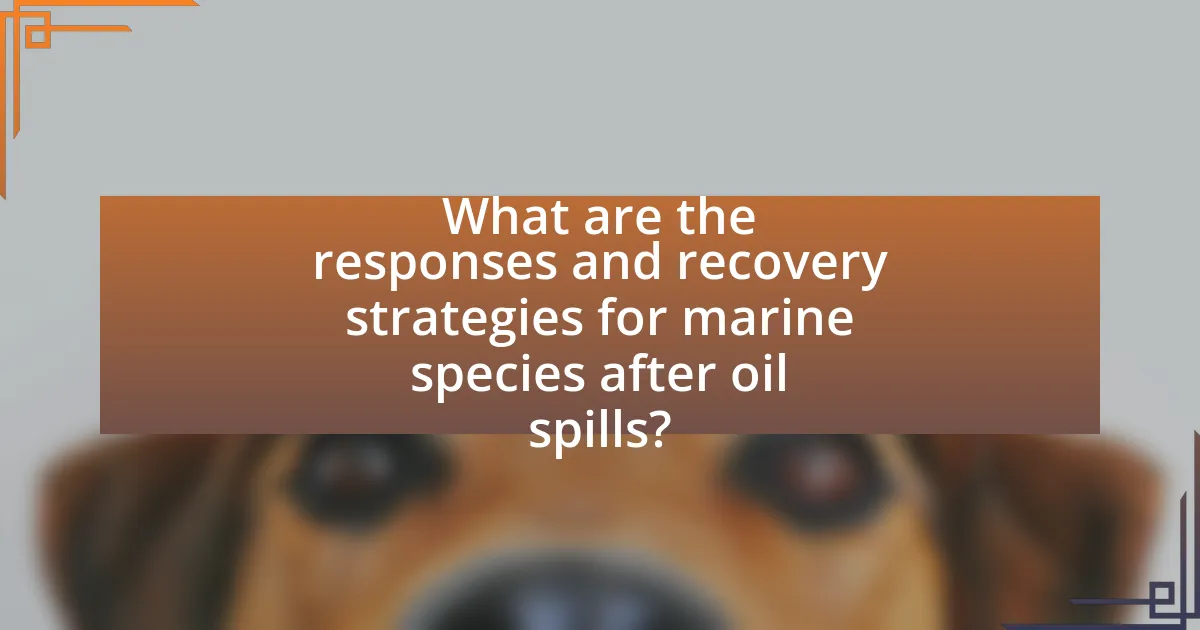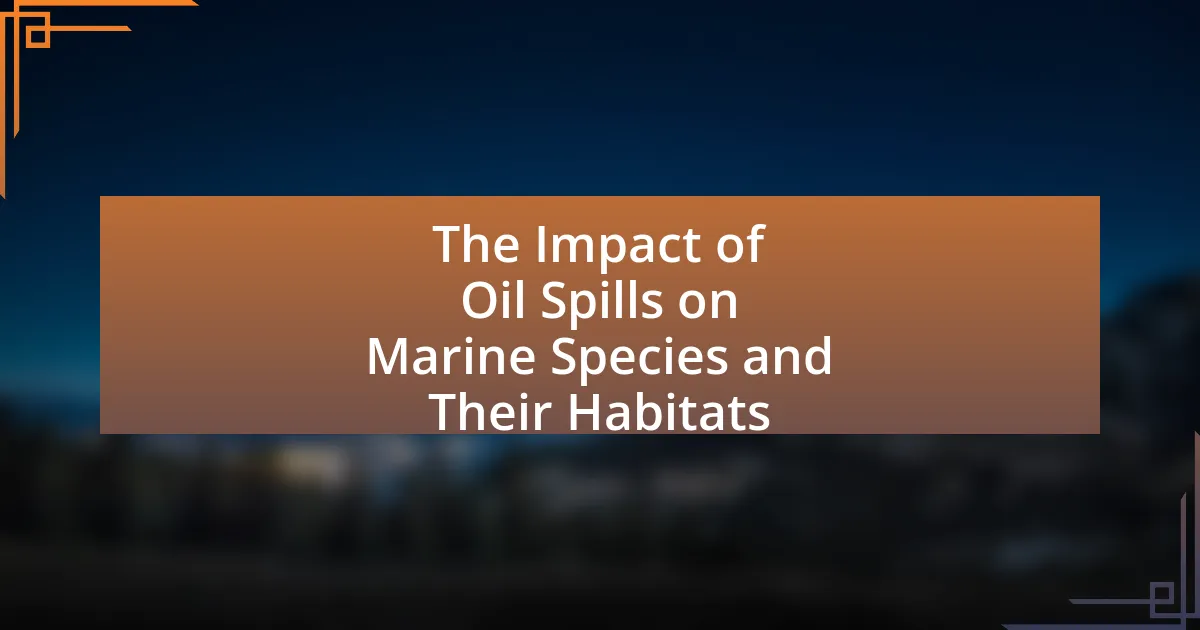The article focuses on the impact of oil spills on marine species and their habitats, detailing the immediate and long-term ecological damage caused by such events. It highlights how oil spills lead to toxic exposure, habitat degradation, and disruptions in reproductive systems among various marine organisms, including fish, birds, and mammals. The article also discusses the mechanisms through which oil spills affect marine environments, the consequences for biodiversity, and the responses and recovery strategies for affected species. Additionally, it emphasizes the importance of effective oil spill response practices and individual actions to protect marine ecosystems from future spills.

What are the effects of oil spills on marine species and their habitats?
Oil spills have detrimental effects on marine species and their habitats, leading to immediate and long-term ecological damage. Marine organisms, including fish, birds, and mammals, suffer from toxic exposure to oil, which can cause physiological harm, reproductive issues, and increased mortality rates. For instance, studies have shown that oil exposure can disrupt the endocrine systems of fish, leading to developmental abnormalities and reduced populations. Additionally, oil spills contaminate habitats such as coral reefs and mangroves, which serve as critical breeding and feeding grounds for various marine species. The degradation of these habitats can result in loss of biodiversity and the collapse of local ecosystems, as evidenced by the 1989 Exxon Valdez oil spill, which caused extensive damage to the Prince William Sound ecosystem, leading to long-lasting impacts on local wildlife populations.
How do oil spills impact different marine species?
Oil spills significantly harm various marine species by contaminating their habitats and disrupting their biological functions. For instance, fish and shellfish can suffer from reduced oxygen levels and toxic exposure, leading to decreased reproduction rates and increased mortality. Studies have shown that oil exposure can cause developmental abnormalities in fish embryos, impacting species like salmon and herring. Marine mammals, such as seals and dolphins, face risks from oil coating their fur or skin, which can impair their ability to regulate body temperature and lead to hypothermia. Additionally, seabirds ingesting oil while preening can suffer from internal organ damage and reduced survival rates. Research indicates that the 2010 Deepwater Horizon oil spill resulted in long-term declines in fish populations and reproductive issues in marine life, highlighting the extensive and lasting impact of oil spills on marine ecosystems.
What are the immediate effects of oil exposure on marine life?
The immediate effects of oil exposure on marine life include toxicity, suffocation, and disruption of reproductive processes. Marine organisms, such as fish and invertebrates, experience acute toxicity due to the harmful chemicals in oil, which can lead to death or impaired physiological functions. For example, studies have shown that oil exposure can cause gill damage in fish, leading to suffocation and reduced oxygen uptake. Additionally, oil can interfere with the reproductive systems of marine species, resulting in decreased fertility and abnormal development in embryos. Research conducted by the National Oceanic and Atmospheric Administration (NOAA) indicates that oil spills can lead to significant mortality rates in affected populations, highlighting the severe and immediate impact of oil exposure on marine ecosystems.
How do oil spills affect the reproductive systems of marine species?
Oil spills adversely affect the reproductive systems of marine species by causing hormonal disruptions and developmental abnormalities. Research indicates that exposure to polycyclic aromatic hydrocarbons (PAHs) found in oil can lead to reduced fertility, altered sex ratios, and impaired development of embryos in species such as fish and mollusks. For instance, studies have shown that fish exposed to oil exhibit changes in reproductive hormone levels, resulting in decreased egg production and poor sperm quality. Additionally, the National Oceanic and Atmospheric Administration (NOAA) has documented that oil exposure can lead to malformations in developing embryos, further impacting population sustainability.
What are the long-term consequences of oil spills on marine ecosystems?
Oil spills have severe long-term consequences on marine ecosystems, including habitat degradation, loss of biodiversity, and disruption of food webs. The toxic components of oil can persist in the environment for years, affecting the health of marine organisms. For instance, studies have shown that oil can cause chronic health issues in fish and marine mammals, leading to reduced reproductive success and increased mortality rates. Additionally, oil spills can alter the composition of marine communities, favoring some species over others and leading to a decline in overall biodiversity. Research conducted after the Exxon Valdez oil spill revealed that certain species, such as herring and sea otters, experienced long-lasting population declines due to habitat destruction and toxic exposure. These impacts highlight the enduring nature of oil spill consequences on marine ecosystems.
How do oil spills alter food chains in marine environments?
Oil spills disrupt food chains in marine environments by introducing toxic substances that harm various trophic levels. When oil contaminates water, it affects primary producers like phytoplankton, which are crucial for energy transfer in the food web. Studies show that oil exposure can reduce phytoplankton growth by up to 50%, leading to decreased food availability for herbivorous zooplankton. This decline cascades through the food chain, impacting fish populations that rely on zooplankton for sustenance. Additionally, higher trophic levels, such as marine mammals and birds, suffer from reduced prey availability and increased toxicity in their food sources, ultimately threatening their survival and reproductive success. Research indicates that oil spills can lead to long-term ecological shifts, altering species composition and abundance in affected areas.
What is the impact of oil spills on biodiversity in marine habitats?
Oil spills significantly reduce biodiversity in marine habitats by causing immediate and long-term harm to various species. The toxic components of oil can lead to the death of marine organisms, including fish, birds, and marine mammals, disrupting food webs and ecosystem functions. For instance, the 2010 Deepwater Horizon oil spill resulted in the death of an estimated 1 million birds and significant declines in fish populations, such as the Gulf of Mexico’s red snapper and bluefin tuna. Additionally, oil spills can lead to habitat degradation, affecting breeding and feeding grounds, which further exacerbates the decline in biodiversity. Studies have shown that recovery of affected ecosystems can take decades, highlighting the lasting impact of oil spills on marine biodiversity.

What are the mechanisms through which oil spills affect marine habitats?
Oil spills affect marine habitats primarily through physical, chemical, and biological mechanisms. Physically, oil coats marine organisms and habitats, leading to suffocation of fish and invertebrates, and smothering of coral reefs and seabeds. Chemically, toxic compounds in oil disrupt cellular processes in marine life, causing acute and chronic health issues, including reproductive failures and increased mortality rates. Biologically, oil spills alter food webs by affecting primary producers like phytoplankton, which are crucial for the marine ecosystem, leading to reduced food availability for higher trophic levels. Studies have shown that oil exposure can lead to long-term ecological changes, as seen in the aftermath of the Exxon Valdez spill, where certain fish populations took decades to recover.
How does oil contamination change the physical and chemical properties of water?
Oil contamination alters the physical and chemical properties of water by introducing hydrocarbons that affect its density, viscosity, and surface tension. The presence of oil decreases water’s density, making it less buoyant, while increasing viscosity, which impairs the movement of aquatic organisms. Additionally, oil contamination raises the surface tension of water, disrupting the ability of organisms to access oxygen and nutrients. Chemically, oil introduces toxic compounds that can harm aquatic life and disrupt biochemical processes, leading to long-term ecological impacts. Studies have shown that even small concentrations of oil can significantly affect the solubility of oxygen in water, which is critical for marine species’ survival.
What are the effects of oil on water temperature and oxygen levels?
Oil significantly affects water temperature and oxygen levels by creating a barrier on the water’s surface, which reduces heat exchange and oxygen diffusion. This barrier can lead to elevated water temperatures beneath the oil layer due to decreased evaporation and increased solar heating. Additionally, the presence of oil decreases dissolved oxygen levels in the water, as oil can inhibit the oxygen exchange between the water and the atmosphere. Studies have shown that oil spills can lead to hypoxic conditions, which are detrimental to marine life, as many aquatic organisms require specific oxygen levels to survive. For instance, research published in the journal “Environmental Science & Technology” indicates that oil contamination can reduce oxygen levels by up to 50% in affected areas, severely impacting marine ecosystems.
How does oil affect sediment quality in marine environments?
Oil negatively affects sediment quality in marine environments by introducing toxic compounds that alter the physical and chemical properties of sediments. When oil spills occur, hydrocarbons can bind to sediment particles, leading to changes in sediment composition and structure. This contamination can reduce the availability of nutrients and oxygen in the sediment, impairing the growth of benthic organisms. Studies have shown that oil-affected sediments can exhibit increased toxicity levels, which can persist for years, impacting the entire marine ecosystem. For instance, research published in “Environmental Science & Technology” by Wang et al. (2017) demonstrated that oil contamination significantly decreased microbial diversity and activity in sediments, further illustrating the detrimental effects on sediment quality and marine life.
What role do weathering and biodegradation play in oil spill impacts?
Weathering and biodegradation significantly mitigate the impacts of oil spills on marine environments. Weathering processes, including evaporation, dispersion, and emulsification, reduce the concentration of oil in the water, thereby lessening its toxicity to marine life. For instance, studies show that within days of an oil spill, volatile compounds evaporate, decreasing the harmful effects on surface-dwelling organisms. Biodegradation, facilitated by microorganisms, further breaks down hydrocarbons into less harmful substances, promoting recovery of affected ecosystems. Research indicates that certain bacteria can degrade up to 90% of oil within weeks under optimal conditions, highlighting the crucial role of natural attenuation in restoring marine habitats post-spill.
How does the natural degradation process influence marine habitats?
The natural degradation process significantly influences marine habitats by breaking down pollutants, such as oil, and restoring ecological balance. This process involves microbial activity, physical weathering, and chemical reactions that gradually reduce the concentration of harmful substances in the environment. For instance, studies have shown that certain bacteria can degrade hydrocarbons from oil spills, leading to a decrease in toxicity and allowing for the recovery of affected marine ecosystems. Additionally, the rate of degradation can vary based on environmental conditions, such as temperature and nutrient availability, which further impacts the resilience and recovery of marine habitats.
What factors affect the rate of oil degradation in marine environments?
The rate of oil degradation in marine environments is primarily affected by factors such as temperature, microbial activity, oil composition, and environmental conditions. Higher temperatures generally increase the rate of degradation due to enhanced microbial metabolism. Microbial activity plays a crucial role, as specific bacteria can break down hydrocarbons in oil, with studies showing that certain species can degrade oil compounds significantly faster than others. The composition of the oil itself, including its viscosity and the presence of toxic compounds, also influences degradation rates; lighter oils tend to degrade more quickly than heavier oils. Additionally, environmental conditions such as wave action, salinity, and nutrient availability can either facilitate or hinder the degradation process, with turbulent waters promoting dispersion and microbial access to oil.

What are the responses and recovery strategies for marine species after oil spills?
Marine species respond to oil spills through various physiological and behavioral adaptations, while recovery strategies include habitat restoration, rehabilitation of affected organisms, and monitoring of ecosystems. For instance, species may exhibit stress responses, such as altered feeding behavior or increased mortality rates, as a direct consequence of exposure to toxic compounds in oil. Recovery strategies are implemented by organizations like NOAA, which focuses on cleaning up affected habitats, rehabilitating wildlife, and conducting long-term ecological assessments to ensure the resilience of marine ecosystems. Studies have shown that effective response and recovery efforts can significantly enhance the survival rates of impacted species, as evidenced by the successful rehabilitation of oiled seabirds and the restoration of coastal habitats post-spill.
How do marine species adapt to oil spill impacts?
Marine species adapt to oil spill impacts through various physiological and behavioral changes. For instance, some fish species can alter their metabolic rates to cope with reduced oxygen levels caused by oil contamination. Additionally, certain invertebrates exhibit increased tolerance to toxic compounds found in oil, allowing them to survive in affected habitats. Research has shown that species like the Atlantic killifish have developed genetic adaptations that enhance their resilience to pollutants, demonstrating a capacity for rapid evolutionary change in response to environmental stressors. These adaptations are crucial for survival and recovery in ecosystems impacted by oil spills.
What are the behavioral changes observed in marine species post-spill?
Marine species exhibit significant behavioral changes post-oil spill, including altered feeding patterns, increased stress responses, and changes in reproductive behaviors. For instance, studies have shown that fish may avoid contaminated areas, leading to reduced foraging efficiency and altered predator-prey dynamics. Additionally, species such as seabirds and marine mammals often display increased aggression and altered social structures due to stress from exposure to toxic substances. Research conducted after the Deepwater Horizon spill indicated that certain fish species experienced impaired sensory functions, affecting their ability to detect predators and food sources. These behavioral shifts can have long-term ecological consequences, disrupting marine ecosystems and food webs.
How do some species show resilience to oil contamination?
Some species demonstrate resilience to oil contamination through physiological adaptations and behavioral changes that enable survival in polluted environments. For instance, certain bacteria can metabolize hydrocarbons found in oil, effectively breaking down toxic compounds and facilitating ecosystem recovery. Research has shown that species like the Gulf of Mexico’s mangroves can recover from oil exposure due to their ability to regenerate quickly and filter pollutants. Additionally, some fish species exhibit altered reproductive strategies, allowing them to thrive despite environmental stressors. These adaptations highlight the capacity of specific organisms to endure and recover from the adverse effects of oil spills.
What are the best practices for mitigating the effects of oil spills on marine life?
The best practices for mitigating the effects of oil spills on marine life include immediate containment and recovery of the oil, application of bioremediation techniques, and monitoring of affected ecosystems. Containment and recovery, such as using booms and skimmers, prevent further spread of oil and minimize exposure to marine organisms. Bioremediation involves introducing microorganisms that can degrade oil, which has been shown to enhance natural recovery processes in marine environments. Monitoring ecosystems post-spill is crucial for assessing recovery and implementing additional protective measures. Studies indicate that timely response and effective cleanup can significantly reduce the long-term impacts of oil spills on marine species and their habitats.
What strategies can be implemented for effective oil spill response?
Effective oil spill response strategies include immediate containment, recovery, and remediation techniques. Immediate containment involves deploying booms to prevent the spread of oil, while recovery techniques utilize skimmers and vacuum trucks to remove oil from the water surface. Remediation strategies, such as bioremediation, employ microorganisms to break down oil compounds, enhancing natural degradation processes. Historical data shows that the Exxon Valdez oil spill response, which included these strategies, ultimately led to significant recovery of affected marine habitats over time.
How can restoration efforts support the recovery of affected marine habitats?
Restoration efforts can support the recovery of affected marine habitats by implementing targeted interventions that rehabilitate ecosystems and promote biodiversity. These efforts often include the removal of pollutants, replanting of native vegetation, and the restoration of natural water flow, which collectively help to restore the ecological balance. For instance, studies have shown that the reintroduction of native species can enhance habitat resilience, as evidenced by the successful recovery of seagrass beds in areas impacted by oil spills, which provide critical habitat for various marine species. Additionally, restoration projects can improve water quality, which is essential for the survival of marine organisms, thereby facilitating the overall recovery of the ecosystem.
What can individuals do to help protect marine species from oil spills?
Individuals can help protect marine species from oil spills by actively participating in local conservation efforts and advocating for policies that prevent oil drilling in sensitive areas. Engaging in beach clean-ups removes debris that can harm marine life, while supporting organizations focused on marine conservation raises awareness and funds for protective measures. Additionally, individuals can reduce their personal oil consumption by using alternative energy sources and promoting sustainable practices, which collectively decrease the likelihood of oil spills. According to the National Oceanic and Atmospheric Administration, oil spills can have devastating effects on marine ecosystems, making proactive individual actions crucial for the preservation of marine species.
